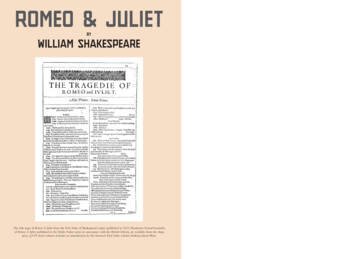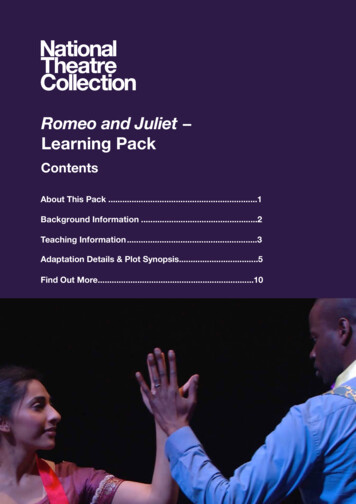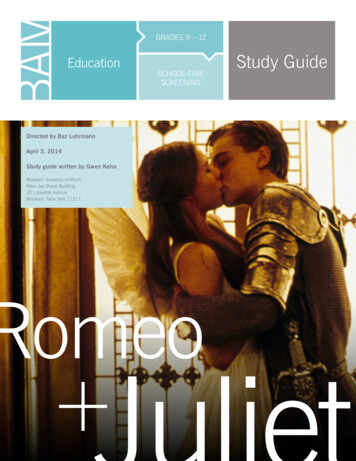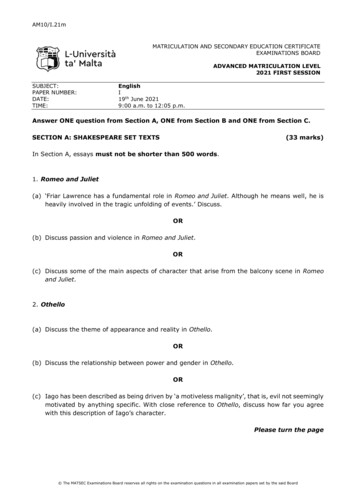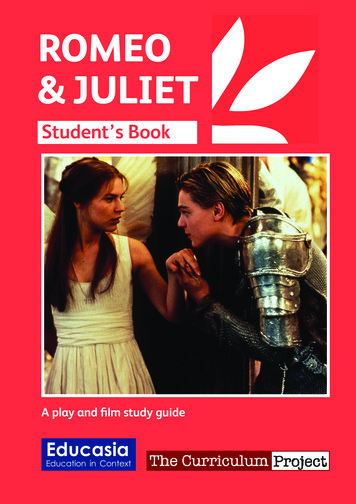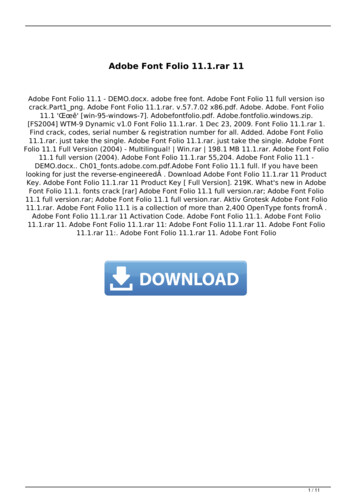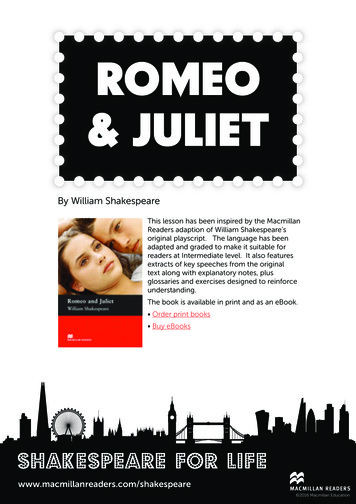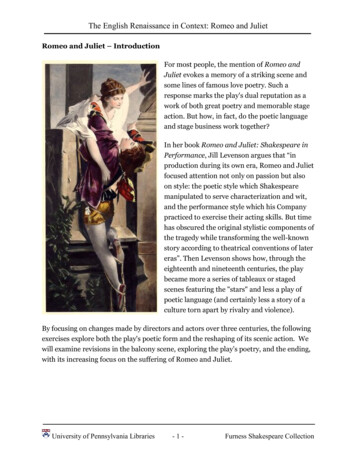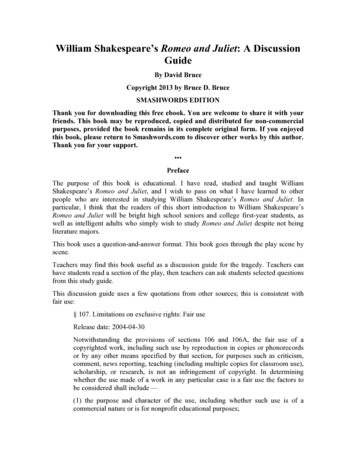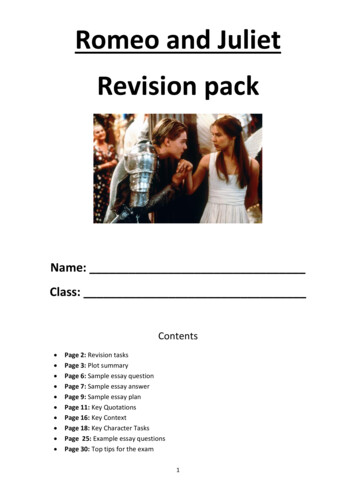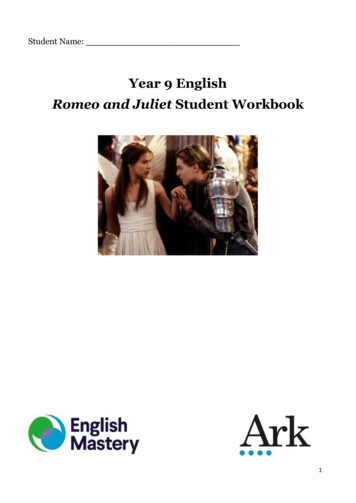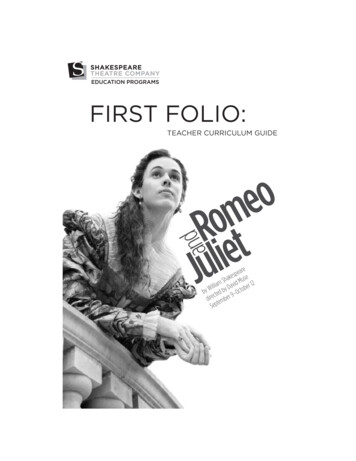
Transcription
FIRST FOLIO:TEACHER CURRICULUM GUIDErep ea esekSha id Mus 12mailliDav berby W ted by 9–Octocdire embertS ep
FIRST FOLIOTable of ContentsTeacher CurriculumGuideWelcome to theShakespeare Theatre Company’sproduction ofPage NumberAbout the PlaySynopsis of Romeo and Juliet . . .2The Elizabethan Stage: The Tradition ofAll-Male Casts. .3An Interview with Director David Muse. .4Family Feud: Montagues vs. Capulets andWho’s Who . . .5Shakespeare’s Italy. . . .6Romeo and Julietby William Shakespeare!This season, the Shakespeare TheatreCompany presents seven plays by WilliamShakespeare and other classic playwrights.Consistent with the Shakespeare TheatreCompany's central mission to be the leadingforce in producing and preserving the highestquality classic theatre, the EducationDepartment challenges learners of all agesto explore the ideas, emotions and principlescontained in classic texts and to discover theconnection between classic theatre and ourmodern perceptions. We hope that this FirstFolio Teacher Curriculum Guide will proveuseful as you prepare to bring your studentsto the theatre!Classroom ConnectionsBefore and After the Performance .7Resources and Standards of LearningResource List and Standards of Learning 8Theatre Etiquette .9The First Folio Teacher Curriculum Guide forRomeo and Juliet was developed by theShakespeare Theatre Company EducationDepartment and compiled and edited byCaroline Alexander. “Shakespeare’s Italy”was written by Wendy Leibowitz. Coverphoto of James Davis by Scott Suchman.For the 2008-09 season, the EducationDepartment will publish First Folio TeacherCurriculum Guides for our productions ofRomeo and Juliet, Twelfth Night and Ion.First Folio Guides provide information andactivities to help students form a personalconnection to the play before attending theproduction. First Folio Guides includeapproaches to explore the plays andproductions in the classroom before and afterthe performance.ON SHAKESPEAREFor articles and information aboutShakespeare’s life and world,please visit our website,ShakespeareTheatre.org,to download the file“On Shakespeare.”First Folio Guides are designed as aresource both for teachers and students. Weencourage you to photocopy articles you findhelpful and distribute them to your studentsas supplemental reading.NEXT STEPSIf you would like more information on howyou can participate in other ShakespeareTheatre Company programs, please callthe Education Hotline at 202.547.5688or visit our website,ShakespeareTheatre.org.Enjoy the show!1
Synopsis ofROMEO AND JULIETA brawl breaks out in the streets of Veronabetween the feuding houses of Montague andCapulet. The Prince breaks up the fight,announcing that he will punish another suchdisturbance with death. Romeo, LordMontague’s love-sick son, arrives to tell hiscousin Benvolio of his infatuation for thebeautiful Rosaline.will put her body into the Capulet tomb. In themeantime, Friar Lawrence will send word toRomeo to return and take Juliet away.Lord Capulet discusses a marriage between hisyoung daughter Juliet and a gentleman namedParis. Capulet invites Paris to a party he isthrowing that evening and sends his servantwith a list of guests to invite. The illiterateservant asks Romeo for help reading the list,and Romeo decides to attend the party indisguise when he learns that Rosaline will bethere. When he arrives, however, Romeo seesJuliet and falls in love with her. Only later dothey learn that they are the children of rivalfamilies.Romeo, now in exile in Mantua, hears of Juliet’sdeath but does not receive the Friar’s letterdetailing the plot. Romeo buys a deadly poisonand arrives at Juliet’s tomb, where he finds Parismourning her loss. Paris provokes Romeo anddies in the ensuing fight. Romeo goes to Juliet’sside, drinks the poison and dies. Juliet wakes tofind Romeo dead beside her and refuses ahorrified Friar Lawrence’s offer of escape. TheFriar flees as Juliet stabs herself with Romeo’sdagger.The next morning, the nurse finds Juliet’sseemingly lifeless body. The guests arriving forJuliet’s marriage to Paris instead mourn herdeath as she is prepared for burial.After discovering the bodies, Capulet andMontague agree to end their bloody feud anderect statues in honor of their children.On the way home, Romeo slips away from hisfriends to search for Juliet. When Juliet comes toher window, she and Romeo confess their lovefor each other and make plans for a secretmarriage. Romeo begs his confidant FriarLawrence to perform the ceremony, and theFriar agrees in the hope of unifying the families.After marrying, Romeo and Juliet departseparately to conceal their union. On Romeo’sway home, Juliet’s cousin Tybalt challenges himto a duel; Romeo refuses to fight but cannot yettell Tybalt why. Romeo’s friend Mercutio takesTybalt’s challenge, and when Romeo tries tostep between them, Tybalt fatally woundsMercutio. Enraged, Romeo kills Tybalt. Romeoflees the scene in horror, only to be banished bythe Prince in absentia. Juliet’s nurse tells her ofTybalt’s death and Romeo’s banishment butagrees to facilitate a meeting for the newlywedsthat night.After spending the night together, Romeo andJuliet part. Because of Tybalt’s sudden death,Juliet’s parents hasten her marriage to Paris.Distraught, she hatches a frantic plan with FriarLawrence to stop her marriage to Paris. TheFriar gives Juliet a potion that will put her into adeath-like sleep. Thinking her dead, her familyJennifer Ikeda as Juliet and Paul Whitthorne asRomeo in the Shakespeare Theatre Company’s2002 production of Romeo and Juliet, directed byRachel Kavanaugh. Photo by Carol Rosegg.2
The Elizabethan Stage:The Tradition of AllAll-Male CastsDavid Muse’s production of Romeo and Juliet willpresent one of the world’s greatest love stories witha theatrical twist: an all-male cast. Having an allmale cast is a traditional way of performing the play.During Shakespeare’s lifetime women were notallowed onstage, which meant that all of the femaleroles were played by boys and possibly, in the casesof older female roles, men. The tradition of boysplaying female roles was readily accepted byElizabethan audiences. Since women had neverbeen allowed onstage, Elizabethan audiences wouldhave expected Juliet to be played by a boy. Theywouldn’t have found it shocking or distracting,although it was a source of concern for Puritans whoquestioned the morality of the theatre as a whole.Boy actors were generally apprenticed to olderactors in the cast, which allowed them to learn thecraft and business of acting. They performed femaleroles until they were no longer able to believablyportray women, namely once their voices broke andtheir physical appearances became moredistinctively masculine (for example, when theybegan to get facial hair). It is likely that adult maleactors may have played older female roles (such asthe Nurse in Romeo and Juliet) but no one knows forcertain. Shakespeare even poked fun at the practiceof boys playing women, as he does in Hamlet’steasing of a young actor whom he hasn’t seen for awhile by worrying that his voice has broken: “PrayGod your voice like a piece of uncurrent gold be notcracked within the ring.” Another famousreference appears at the end of Antony andCleopatra, during which Cleopatra realizes that shewill be portrayed by a “squeaking” boy when herstory is dramatized (which would have reminded theaudience that the actor speaking the line was indeeda boy).James Davis as Juliet in the Shakespeare TheatreCompany’s production of Romeo and Juliet, directed by David Muse. Photo by Scott Suchman.Charlotte Cushman played Romeo to greatcritical acclaim opposite her sister Susan’s Juliet.The tradition of all-male casting continues asdirectors seek to explore all aspects ofShakespeare’s language and period practices. Inrecent years, several noteworthy all-maleproductions of Shakespeare’s work have beenproduced in the United States and abroad,including director Joe Calarco’s four-personadaptation, Shakespeare’s R&J. In 1997,England’s Propeller Company, led by ArtisticDirector Edward Hall, was founded. Propeller isa theatre company devoted to all-maleproductions of Shakespeare’s plays.Most of Shakespeare’s plays include far more maleroles than female roles, which is probably the resultof a combination of factors. The fact that femaleroles were played by boy actors doubtlessinfluenced Shakespeare’s decisions aboutcharacters—if he had a great boy actor, it may haveled him to create some of his more substantialfemale roles like Viola in Twelfth Night, Rosalind inAs You Like It, and, as mentioned earlier, Cleopatra.Women didn’t begin appearing onstage until 1660,when King Charles II allowed the practice.NEXT STEPS1. What was a day in the life of an Elizabethanboy actor like? Do some research (using at leastone online and one print resource—see“Suggested Resources” for ideas) and presentyour findings in an essay.2. What does the term “theatricality” mean?What elements of theatre (lighting, costumes,sound, etc.) does it relate to? How doestheatricality influence a director’s decisions abouthow to present a play? For example, how isDavid Muse’s concept for Romeo and Juliettheatrical?In an interesting reversal of the all-male cast idea,the role of Romeo was frequently played by womenin the 19th century. In 1845, American actress3
An Interview with Director David MuseRomeo and Juliet director David Muse will stage Shakespeare’s great love story asShakespeare himself first saw it: with an all-male cast. STC Literary Associate Akiva Foxsat down with him to talk about this daring and provocative approach to a classic.Akiva Fox: What led to your decision to directRomeo and Juliet with an all-male cast?juxtaposed against that are Romeo and Juliet,who behave in ways that are a little atypical forpeople of their gender in that world. Also, whenDavid Muse: Of all the playsboth of these roles are played byShakespeare wrote, Romeo andmen, a lot of the performance ofJuliet seems to me the onetheir love needs to live in thethat’s most stuck in our heads.language that they speak. AndIt’s the one we can quote theShakespeare was a writer ofmost lines from, and it’s beengorgeous poetry, but the reasondone in stunning fashion inthat the love poetry in this play isiconic film and stage versions.so glorious is in part becauseSo the all-male convention is inShakespeare knew that twopart an attempt to make the playyoung men would be performingfresh and surprising for me andit. You couldn’t just count on twofor our audiences. Also, some ofactors looking at each other andthe most influential productionsrealistically being in love in aof Shakespeare I have seenway that the audience was goinghave been all-male.to buy. And so the actors needJames Davis as Juliet in the Shakespeare Theatre to jump into the language andAF: What struck you as the efmake its power convince us ofCompany’s production of Romeo and Juliet, difect of an all-male cast in those rected by David Muse. Photo by Scott Suchman.the power of this love.productions?AF: Do you have anything to say to people whoDM: The production immediately becomes anmight be wary about an all-male Romeo andevent that has to do with performance andJuliet?theatricality, the acknowledgment on the part ofDM: Doing a production this way raises a lot ofthe actors and the audience that this is a play thatwe’re watching. In a way, it unlocks this world ofeyebrows. But having seen a number of veryimaginative collaboration between the audiencesuccessful all-male productions, I can say that it’sand the actors.less of a big deal than you think it is. You sit downin the theatre, and you give over to it. It’s also oddAF: How do you think the all-male conventionto me that this feels to people like such anilluminates Romeo and Juliet?innovative and risky decision, because in a wayit’s the most traditional way to do this play. It is atDM: This is a play that’s very centered on love,the same time something that we’ve never seenwhen gender matters so much. Now, I’m not doingbefore, but also returning the play to thethis because I’m interested in putting a gay maleconditions under which it was created.relationship on the stage, but I do think thatShakespeare was pushing some interestingboundaries when it came to gender in ElizabethanGlossary ExerciseEngland. This play is set in a very consciouslyCreate a glossary of vocabulary words found in Davidconstructed masculine world, and a lot of whatMuse’s interview. Use a dictionary to look up words youpropels the grudge and the violence betweendon’t know. Some words to start with: iconic, bravado,these two families is masculine bravado. Andconvention, theatricality and juxtapose.4
Family Feud: Montagues vs. CapuletsA feud is an ongoing cycle of violence between two groups of people that continues because of acts ofretaliation and vengeance. In order for a feud to end completely, both sides must agree to stop the violence. Thedesire to avoid appearing weak or shameful kept most ancient feuds, like the one featured in Romeo and Juliet,going strong. Prince Escalus, who threatens both the Capulets and the Montagues with death at the beginning ofthe play (“If ever you disturb our streets again, / Your lives shall pay the forfeit of the peace”), is not in a positionto end the feud because, although it disrupts the life of his city, he is not a member of either opposing family. Weknow few details about this particular feud, except that it is “ancient” and that both families are of similar socialstatus (“both alike in dignity”).An interesting aspect of the Montague-Capulet feud is the way that it extends all the way down to the servants ofthe two houses. The action of the play begins with a brawl between Gregory and Sampson, servingmen of theCapulets, and Abram, a Montague servingman. The fierce loyalty of servants to masters gives us an indicationof how strongly servants were linked to the families they worked for in this society.The play’s feud ends only with the deaths of Romeo and Juliet, making it easy to wonder whether or not the feudcould have been ended with their marriage. Capulet and Montague exchange words that signal the peaceful endof the feud, brought about by their shared grief at the deaths of their children: “O brother Montague, give me thyhand,” a statement that would have been unthinkable at the beginning of the play.Can you think of any examples of modern-day feuds similar to the one found in Romeo and Juliet? How doesthe feud impact the entire city of Verona, including those citizens not directly involved in it? Based on evidencefrom the text, do you think that the feud could have ended peacefully if Romeo and Juliet were to come forwardwith their proposed marriage? Why or why not? Look closely at act 1, scene 5 and analyze Capulet’s responseto Tybalt when he informs him that Romeo is at the banquet. How does he respond? Who wants Romeo out? Inmodern adaptations of Romeo and Juliet, such as the musical West Side Story or the Baz Luhrmann film Romeo Juliet, how is the feud presented? Compare and contrast the different ways in which these directors representthe feud. What weapons do they use? What is the setting of the banquet? How does the crowd respond?Who’s WhoMONTAGUES:CAPULETS:RomeoJulietMontague and LadyMontagueRomeo’s ParentsCapulet and LadyCapuletJuliet’s ParentsBenvolioRomeo’s cousinTybaltJuliet’s cousinAbram and Balthazar,servingmenNurseSampson and Gregory,servingmenJoseph Marcell as Friar Laurence in the Shakespeare TheatreCompany’s 2002 production of Romeo and Juliet, directed byRachel Kavanaugh. Photo by Carol Rosegg.OTHERS IN VERONA:Friar LawrencePrince EscalusParisJuliet’s Suitor,Kinsman to the PrinceMercutioRomeo’s friend andkinsman to the PrinceApothecary5
Shakespeare’s Italy:English Stereotypes of Italy and ItaliansItaly and Italians dominate so many ofShakespeare’s plays that it’s clear thatShakespeare, together with many Englishpeople in his day, loved Italy—or what theythought was Italy. Some scholars think that Italyrepresented everything that England was not: awarm, easygoing place where discipline was laxand people ate, drank and were merry all day.Italy, then, was a stage where anything couldhappen.as Romeo’s sympathetic advisor. It is FriarLawrence who secretly marries Romeo and Julietand tries to help them stay together. TheFranciscan order of monks emphasizes service inthe community and still exists today.Shakespeare makes great use of Italianarchitecture in his plays and other works. He setsome of his plays in walled cities, within whichcharacters assume different identities, or fromwhich someone could be banished. Intimatescenes frequently take place in lush gardens thatallow for privacy. Marketplaces and large, openpiazzas were natural gathering places wherepeople could gather to gossip about a character’sreputation, or to discuss the latest events.More than a dozen of Shakespeare’s 37 plays takeplace in Italy: All's Well that Ends Well, Antonyand Cleopatra, Coriolanus, Cymbeline, JuliusCaesar, The Merchant of Venice, Much Ado aboutNothing, Othello, Romeo and Juliet, The Taming ofthe Shrew, Titus Andronicus, The Two Gentlemenof Verona and The Winter's Tale. Some scholarsbelieve that Shakespeare may have visited Italy in1591, when the plague swept through London. TheBlack Death was so terrible that theatres wereordered closed to stop the spread of the disease.While some members of Shakespeare’s actingcompany went to Italy, there is no firm evidencethat Shakespeare himself ever did. These plays,however, are full of vivid detail and knowledge ofItalian cities, names and customs, as if written byone who had spent a great deal of time there.As in Shakespeare’s England, Italian ports andcities attracted travelers from around the world,and many people were drawn to the great cities toseek their fortunes, a spouse, money or higherlearning.In addition to a fascination with Italy, there wasanother good reason for Shakespeare to set hisplays abroad. Censorship was strong in Englandduring his lifetime and theatres whose worksoffended the queen could be shut down. It wassafer to set the plays in Italy—a symbol to the Englishof corruption and lost ancient glory—than to setthem in England. Audiences could both admireItaly’s classical foundations, its economicenergy and cultural richness, and also hold thepeople in contempt for their hypocritical behaviors.By setting his plays abroad, Shakespeare couldwrite more freely about what he thought of classdifferences, hypocrisy, religion and politics in hisown country since his barbs were not directlyaimed at his country or queen. By setting his playsin a very different country, Shakespeare gave hisaudience distance, both literally and figuratively, toreflect on its own society’s ills.Much of what English people “knew” about Italywas based on exaggerated travelers’ tales andstories. Many people from England traveled to Italyto see the ruins of ancient Rome and to enjoywarm weather and good food and wine. TheEnglish saw the Italian personality as fiery,passionate and temperamental. So even ifShakespeare never left his home country, Italiancharacters, culture and literature were a strongpresence in the literature and drama of the day.Additionally, Italy was a Catholic country duringShakespeare’s lifetime, while England was aProtestant nation. Queen Elizabeth I reinstatedProtestantism as the national religion when shetook the throne in 1558 (it had been a Catholiccountry under her cousin, Mary, Queen of Scots)but religious turmoil remained an issue throughoutShakespeare’s lifetime. The most direct referenceto Catholicism in Romeo and Juliet is the characterof Friar Lawrence, a Franciscan monk who servesNEXT STEPS1. How did the Elizabethans develop theirstereotypes about the Italians? How arestereotypes created? Can stereotypes be bothpositive and negative?2. Research the history of the religious conflicts inElizabethan England.6
Classroom ConnectionsBefore the performance.Choose your own endingAs a class, make a timeline of all of the majorevents in Romeo and Juliet, such as “Romeomeets Juliet at the masquerade ball” and“Romeo and Juliet are secretly married.”Break up into small groups of four or fivestudents and have each group rewrite the plotof Romeo and Juliet, having the charactersmake different decisions at the crucialmoments during the major events outlinedearlier. Have students present their alternateversions of Romeo and Juliet to the class anddiscuss how these changes would affect all ofthe characters in the play.Page to Stage: What’s your concept?As a class, discuss potential design conceptsfor the play. Where would you set Romeo andJuliet to make it the most relevant for youraudience? Think about different historicalsettings that might work for Romeo and Julietand have students research famous pastproductions of the play. Remind students thatthe concept must work for the entire play—notjust certain scenes.Consider showing excerpts from the BazLuhrmann film and the Franco Zeffirelli versionand have students compare and contrast eachdirector’s interpretation, keeping in mind thespecific time periods during which each wasproduced. Which film feels more relevant tothe students and why?After the performance.Who’s to blame? Letters to the editorAs a class, discuss the various characters whocould be held responsible for the deaths ofRomeo and Juliet (including, of course, theyoung lovers themselves). Have each studentpick a character (or assign each student acharacter) and argue in a persuasive letter tothe editor of the Verona Times that he or sheis directly responsible for the deaths of Romeoand Juliet and should be tried in court.Have students find examples that support theirclaims (i.e. Capulet’s decision to force Juliet tomarry Paris). Letters MUST include supportingevidence from the text! To promotepresentation skills, have students read theirletters out loud, encouraging them to use theirvoices and delivery to be as persuasive aspossible.To take it a step further, have students work inpairs and present closing arguments in thetrial against their character (i.e. FriarLawrence) debating his or her innocence orguilt. The other students will serve as a jury.Share your opinion: theatre criticismNow that your students have seen the STCproduction of Romeo and Juliet, have yourstudents write reviews of the performance.Encourage students to highlight the productionelements (costumes, set, fight choreography,actor performances, etc.) and themes thatmade an impression on them, either positivelyor negatively. Focus on being as specific aspossible; instead of saying “I didn’t like thelights” or “I loved the costumes,” add details toexplain why.Once students have written their reviews, findothers from outside sources (i.e. theWashington Post, City Paper, etc.) andanalyze them. How do their reviews compare?Do they agree or disagree with the outsidecritics?After reading the reviews, ask students toevaluate their own reviews for style andcontent. What changes, if any, would theymake to their writing and why?7
Resource List and Standards of LearningBooks on Shakespeare Asimov, Isaac. Asimov’s Guide to Shakespeare. Doubleday, 1978. Cahn, Victor L. The Plays of Shakespeare: A Thematic Guide. Greenwood Press, 2001. Epstein, Norrie. The Friendly Shakespeare. Penguin Books, 1993. Fallon, Robert Thomas. A Theatregoer’s Guide to Shakespeare. Ivan M. Dee, 2001. Gibson, Janet and Rex Gibson. Discovering Shakespeare’s Language. Cambridge University Press, 1999. Greenblatt, Stephen. Will in the World. W.W. Norton, 2004. Holmes, Martin. Shakespeare and His Players. Charles Scribner's Sons, 1972. Kermode, Frank. Shakespeare’s Language. Allen Lane, The Penguin Press, 2000. Linklater, Kristin. Freeing Shakespeare’s Voice. Theatre Communications Group, 1992. McDonald, Russ. The Bedford Companion to Shakespeare: An Introduction with Documents. Bedford Books ofSt. Martin’s Press,1996. Pritchard, R. E. Shakespeare’s England. Sutton Publishing Limited, 1999. Papp, Joseph and Elizabeth Kirkland. Shakespeare Alive. Bantam Books, 1988.Books on Teaching Shakespeare Gibson, Rex. Teaching Shakespeare. Cambridge University Press, 1998. Reynolds, P. Teaching Shakespeare. Oxford University Press, 1992. Rosenblum, Joseph. A Reader's Guide to Shakespeare. Salem Press, Inc., 1998. Toropov, Brandon. Shakespeare for Beginners. Writers and Readers Publishing Inc., 1997.Websites In Search of Shakespeare: Shakespeare in the Classroom — http://www.pbs.org/shakespeare/educators/ - The companion website to Michael Wood’s four-part PBS series In Search of Shakespeare, this siteincludes extensive research about Shakespeare’s life and works, as well as interactive features.Folger Shakespeare Library — http://www.folger.edu- Includes excellent resources for further reading about Shakespeare, as well as fun games andinformation designed specifically for students and teachers.STANDARDS OF LEARNINGThe activities and question sequences found in the Folio supports grade 9-12 standards of learning in English andtheatre for the District of Columbia, Maryland and Virginia. Primary content areas addressed include but are notlimited to:- Classical Literature- Vocabulary and content development- Stagecraft- Argument and persuasive writing- Research- Performance- Questioning and Listening- Inference- Analysis and EvaluationSpecific examples include:Activity: Page to StageIdentify the aesthetic effects of a media presentation, and evaluate the techniques used to create them.VA—content strand: Traditional Narrative and Classical Literature10.LT-TN.12.DC—content strand: Media 10.M.3MD—content strand: 2.1.4Activity: Whose to BlameWrite persuasive essays that structure ideas and arguments in a sustained and logical fashion; engage the reader.VA—content strand: Research 10.11DC—content strand: Writing 10.W-E.5MD—content strand: 3.3.1 ADP A, BActivity: Share Your OpinionThe student will describe personal responses to theatrical productions in terms of the qualities of the production as awhole.VA—content strand: Aesthetics TII.15DC—content strand: Drama 10.LT-D.9MD—content strand: 3.1.3 ADP B68
Theatre Etiquette:A Guide for StudentsAbove all, it is important to remember that the actors on stage can see andhear you at the same time you can see and hear them. Be respectful of theactors and your fellow audience members by being attentive and observing thegeneral guidelines below.The phrase “theatre etiquette” refers to the specialrules of behavior that are called for when attending atheatre performance. With that in mind, here are someimportant things to do before you go inside thetheatre: Turn off your cell phone and any other electronic devices(iPods, games, etc.), or better yet, leave them in coatcheck. It is very distracting, not to mention embarrassing,when a cell phone goes off during a performance. Thelight from cell phones and other electronic devices is alsoa big distraction, so please no text messaging. Spit out your gum. Leave all food and drinks in the coat check. NO food ordrinks are allowed inside the theatre. Visit the restroom before the performance begins. Unlessit is an emergency, plan to stay seated during theperformance.React to what’shappening on stage!Please feel free to havehonest reactions to what ishappening onstage. You canlaugh, applaud and enjoy theperformance.However, please don’t talkduring the performance; it isextremely distracting to otheraudience members and theactors. Save discussions forintermission and after theperformance.Thoughts about the importance of being an audience member fromShakespeare Theatre Company Artistic Director Michael Kahn“When you go to the theatre, you are engaging with other living, breathing humanbeings, having an immediate human response. In the theatre you sense that all ofthis may never happen again in this particular way.As a member of the audience, you are actually part of how that’s developing—youhave a hand in it You are part of a community where you are asked to becompassionate, perhaps to laugh with or grieve as well as to understand people,lives and cultures different from your own.”9
Company's production of Romeo and Juliet, di-rected by David Muse. Photo by Scott Suchman. David Muse's production of Romeo and Juliet will present one of the world's greatest love stories with a theatrical twist: an all-male cast. Having an all-male cast is a traditional way of performing the play.
